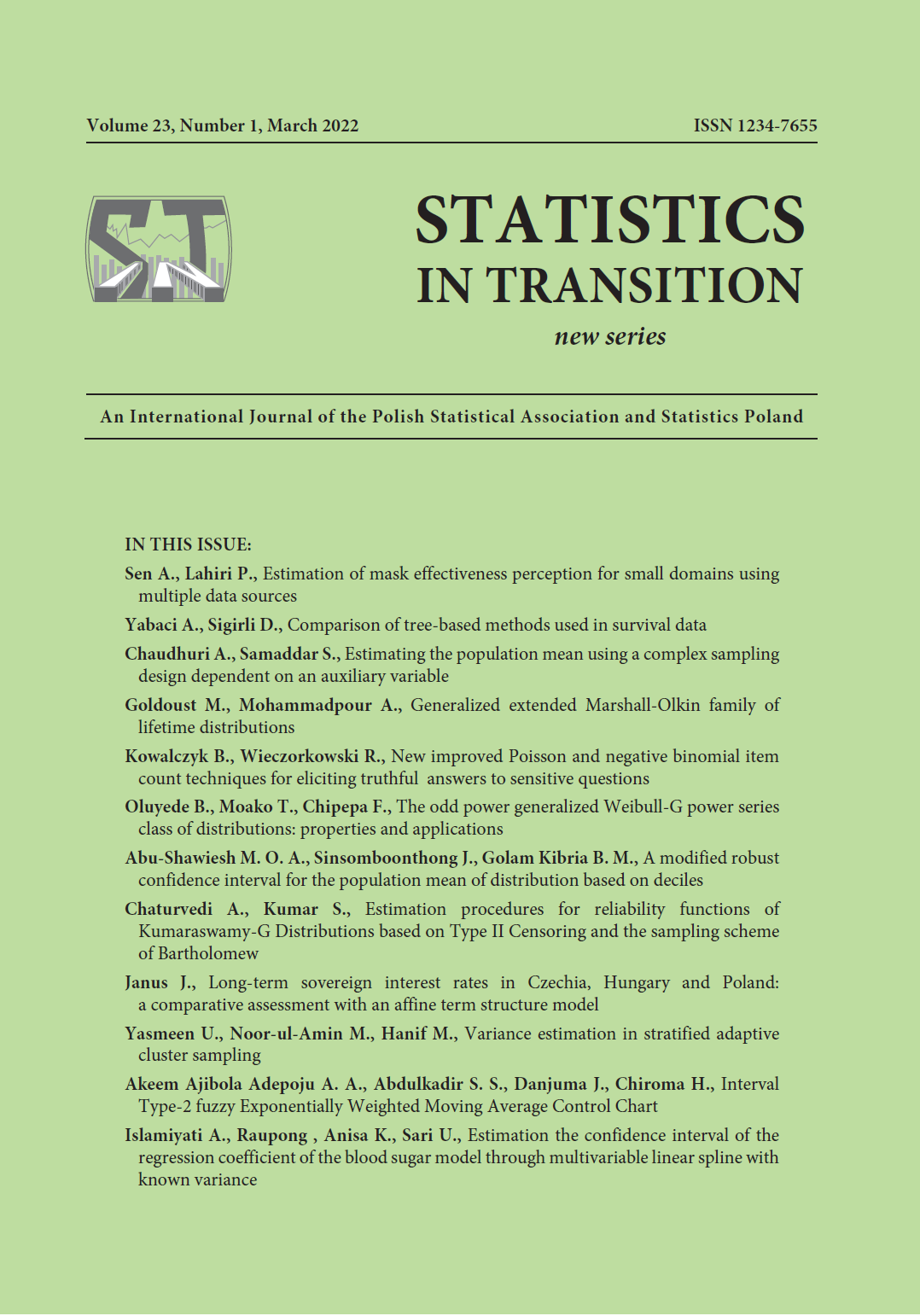ARTICLE
ABSTRACT
Estimates from confidence intervals are more powerful than point estimates, because there are intervals for parameter values used to estimate populations. In relation to global conditions, involving issues such as type 2 diabetes mellitus, it is very difficult to make estimations limited to one point only. Therefore, in this article, we estimate confidence intervals in a truncated spline model for type 2 diabetes data. We use a non-parametric regression model through a multi-variable spline linear estimator. The use of the model results from the irregularity of the data, so it does not form a parametric pattern. Subsequently, we obtained the interval from beta parameter values for each predictor. Body mass index, HDL cholesterol, LDL cholesterol and triglycerides all have two regression coefficients at different intervals as the number of the found optimal knot points is one. This value is the interval for multivariable spline regression coefficients that can occur in a population of type 2 diabetes patients.
KEYWORDS
confidence interval, diabetes, known variance, spline.
REFERENCES
Aprilia, B., Islamiyati, A., Anisa, (2019). Platelet modeling based on hematocrit in DHF patients with spline quantile regression, International Journal of Academic and Applied Research, Vol. 3(12), pp. 51–54.
Chamidah, N., Gusti, K. H., Tjahjono, E., Lestari, B., (2019). Improving of classification accuracy of cyst and tumor using local polynomial estimator, Telkomnika, Vol. 17, pp. 1492–1500.
Chamidah, N., Saifudin, T., (2013). Estimation of children growth curve based on kernel smoothing in multi-response nonparametric regression, Applied Mathematical Sciences, Vol. 7(37), pp. 1839–1847.
David, J.C., Tom, G. F., Douglas, N., (2001). Confidence intervals for nonparametric curve estimates toward more uniform pointwise coverage, Journal of the American Statistical Association, Vol. 96(453), pp. 233–246.
Islamiyati, A., (2022). Spline longitudinal multi-response model for the detection of lifestyle-based changes in blood glucose of diabetic patients. Current Diabetes Reviews, Published on: 14 January.
Islamiyati, A., Fatmawati, Chamidah, N., (2018). Estimation of covariance matrix on bi-response longitudinal data analysis with penalized spline regression, Journal of Physics: Conference Series, Vol. 979, 012093.
Islamiyati, A., Fatmawati, Chamidah, N., (2020). Changes in blood glucose 2 hours after meals in Type 2 diabetes patients based on length of treatment at Hasanuddin University Hospital, Indonesia, Rawal Medical Journal, Vol. 45(1), pp. 31–34.
Islamiyati, A., Kalondeng, A., Sunusi, N., Zakir, M., Amir, A. K., (2022). Biresponse nonparametric regression model in principal component analysis with truncated spline estimator. Journal of King Saud University-Science, Vol. 34, 101892, pp. 1–9.
Islamiyati, A., Sunusi, N., Kalondeng, A., Fatmawati, F., Chamidah, N., (2020). Use of two smoothing parameters in penalized spline estimator for bi-variate predictor non-parametric regression model, Journal of Sciences: Islamic Republic of Iran, Vol. 31(2), pp. 175–183.
Islamiyati, A., Raupong, Anisa, (2019). Use of penalized spline linear to identify change in pattern of blood sugar based on the weight of diabetes patients, International Journal of Academic and Applied Research, Vol. 3(12), pp. 75–78.
Islamiyati, A., Fatmawati, Chamidah, N., (2019). Ability of covariance matrix in biresponse multi-predictor penalized spline model through longitudinal data simulation, International Journal of Academic and Applied Research, Vol. 3(3), pp. 8–11.
Islamiyati, A, Fatmawati, Chamidah, N., (2020). Penalized spline estimator with multi smoothing parameters in bi-response multi-predictor regression model for longitudinal data, Songklanakarin Journal of Science and Technology, Vol. 42(4), pp. 897–909.
Lestari, B., Budiantara, I. N., Chamidah, N., (2019). Smoothing parameter selection method for multiresponse nonparametric regression model using smoothing spline and kernel estimators approaches. Journal of Physics: Conference Series, Vol. 1397, 012064.
Mao, W., Zhao, L. H., (2003). Free-knot polynomial splines with confidence intervals, Journal of the Royal Statistical Society Series B, Vol. 65(4), pp. 901–919.
Mardianto, M. F. F., Tjahjono, E., Rifada, M., (2020). Statistical modelling for prediction of rice production in Indonesia using semiparametric regression based on three forms of Fourier series estimator, ARPN Journal of Engineering and Applied Sciences, Vol. 14(15), pp. 2763–2770.
Toulis, P., (2017). A useful pivotal quantity, The American Statistician, Vol. 71(3), pp. 272–274.
Saegusa, T., (2020). Confidence band for a distribution function with merged data from multiple source, Statistic in Transition, Vol. 21(4), pp. 144–158.
Singh, S., (2015). Genetics of type 2 diabetes: advances and future prospect, Journal of Diabetes and Metabolism, Vol. 6(4), pp. 1–8.
Steinskog, D. J., Tjostheim, D. B., Kvamsto, N. G. A., (2007). A cautionary note on the use of the Kolmogorov–Smirnov Test for normality, American Meteorological Society, Vol. 135(3), pp. 1151–1157.
Wang, Y., Wahba, G., (2003). Bootstrap confidence interval for smoothing spline and their comparison to Bayesian confidence intervals, Technical Report University of Wisconsin-Madison USA, No. 193.
